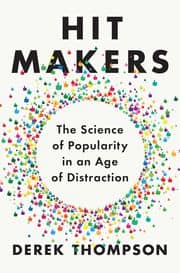What We Like & Why

Have you ever wondered why Claude Monet got so dang famous — while another French impressionist, Gustave Caillebotte, didn’t? Probably not, but Derek Thompson has. And he argues that without Gustave the obscure, Claude, too, would be an artsy footnote. As is often the case, exposure is the key.
In "Hit Makers: The Science of Popularity in an Age of Distraction" (Penguin Press, 344 pp., *** out of four stars), Thompson, a senior editor at The Atlantic*, has written a wonderful book full of such wonderings. He wonders all over the place, as befits a man who likes Shakespeare as well as the movie Dumb and Dumber.
For example, how did the first rock 'n' roll mega-hit, Rock Around the Clock by Bill Haley & His Comets, become what is largely cited as the best-selling vinyl rock single of all time, topping anything Elvis, the Beatles or Michael Jackson churned out? Spoiler alert: luck had a lot to do with it.
While giving Lady Luck her due, Thompson studiously examines the myriad factors that make the things we buy, like and follow so irresistible: whether Facebook, TV shows such as Seinfeld, Bumble (the app, not the insect), even favorite lullabies.
In "Hit Makers," his first book, Thompson tackles this mystery with solid research, ready wit and catchy aphorisms, such as: “People are mysterious and markets are chaos.” Ergo, most new things fail, including eminently worthy novelties. Hits, by definition, are “freaks, outliers, and exceptions.”
Most readers will know this premise, but the author puts meat on the bones of what drives contemporary culture and sales, how “freaks” like Instagram and ESPN come to life. Thompson makes sense of the chaos. He does it by telling stories, including the saga of Raymond Loewy, an immigrant now largely forgotten, who is considered one of the greatest hit makers of the past century and the father of American industrial design.
Loewy devised appealing and efficient new forms for planes (including Air Force One), trains and automobiles, not to mention refrigerators, copy machines and NASA’s first space station, Skylab. His success was predicated on creating something new and better, but not too new: it had to be, in Loewy’s pithy mantra, “Most Advanced, Yet Acceptable.”
Monet and Impressionism also were new in the late 1800s, but Caillebotte not only painted, he was an art collector, too. In his will he left his portfolio of works by Monet, Degas and their ilk to the French government under the condition that the paintings (but not his own work) be hung in the Musée du Luxembourg in Paris. They made quite an impression.
Through such vignettes Thompson shows how the melding of innovation with familiarity, as well as exposure of various kinds, applies to other successful creations. There is nothing new under the sun, or at least totally new. George Lucas described Star Wars as a “Western movie set in outer space,” and his franchise borrowed liberally from Flash Gordon, the 1930s film serial.
But more significant than which movie or pop song is trending and why, is how this brave new digital universe can both unite and divide people.
Thompson recommends a solution: “Content platforms like Facebook could purposely offer disfluent (meaning disparate) feeds, so that a Jewish Connecticut liberal could see the media diet of an evangelical Texas conservative and vice versa.”
As the aphoristic Thompson observes, “for better or worse, politics is entertainment.”